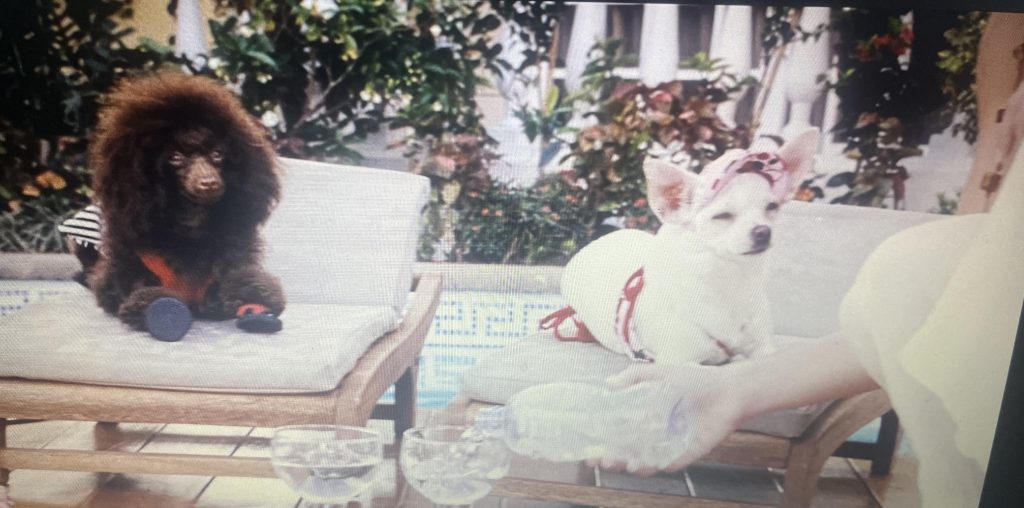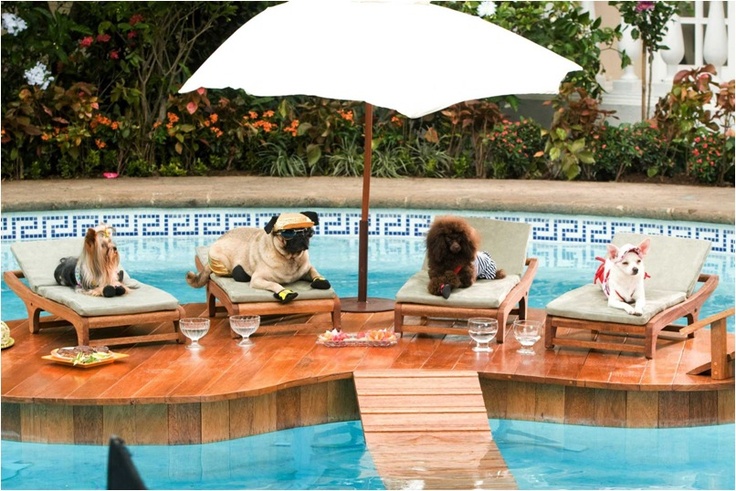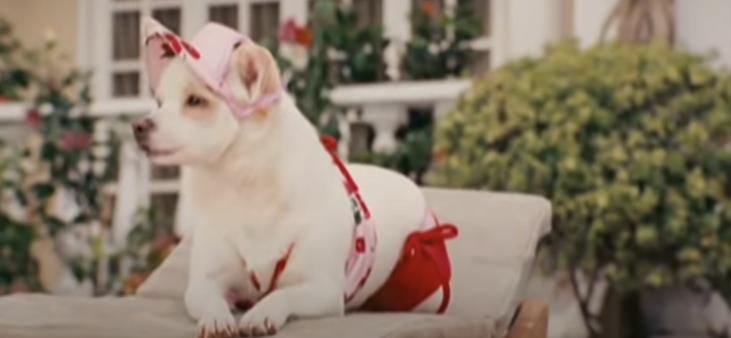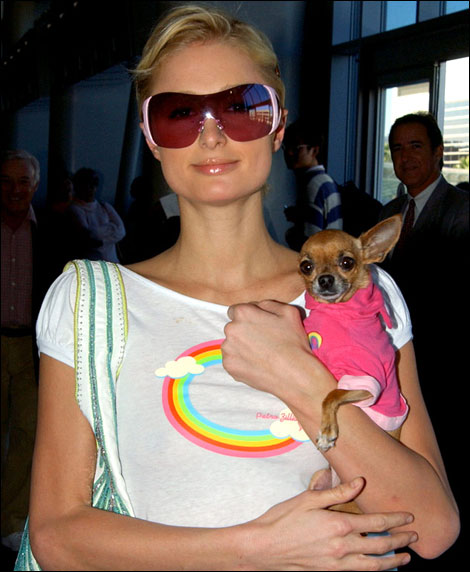
In Beverly Hills Chihuahua, the superiority and entitlement of animals are used as tropes to represent Chloe the chihuahua and her furry friends’ authority over Rachel, Chloe’s dogsitter. This is captured within the pool party scene through the decision to construct dominant representations of the dogs and represent Rachel, the human, as an inferior servant to the dogs. The representation of an inequal power dynamic between several dogs and one human subverts the film cliché that animals are conventionally represented as inferior in contrast to humans. This scene also constructs dominant representations of the dogs to emphasise their importance as individuals and promote the egotistical nature of these dogs. This is evident as the scene begins with a panning shot showing Chloe and her dog friends lounging on sunbeds as Rachel pours Evian bottled water into a glass chalice for each dog. Gosnell’s decision to have the camera focus for a length of time on each dog as Rachel pours water for them one by one immediately establishes the dogs’ identities as superior to Rachel, and simultaneously confirms the existence of an animal-human hierarchy as Rachel’s act of serving them amplifies the conceited behaviour that is used to represent the dogs as entitled and superior. This is constructed through distinctions in the positioning of human and animal characters within this scene to highlight the inequal power dynamic; the dogs remain in relaxed positions and do not move from their sunbeds whereas Rachel is actively moving in frame as she executes her servant-like duties. This coincides with Gosnell’s decision for the camera to follow Rachel’s hands as it pans and use this as only signifier of her existence – establishing the dogs as the superior and authoritative party.
The medium-close up shots of each dog lounging by the swimming pool are accompanied by the soundtrack ‘I’m Too Sexy by Right Said Fred. The superlative and entitled lyrics of the song are used instrumentally to emphasise the superior identities of the dogs and simultaneously injects humour into the scene. This implies that all pampered groups within society share similar self-serving delusions, and these dogs are no different. The combined visuals and audio promoting the dogs’ authority over Rachel is significant to the scene because it demonstrates that these dogs are powerful; this is vital to maintain the scene’s prioritisation of dogs within a human-animal hierarchy. As demonstrated in Figure 1, the dogs’ superiority and expectancy of Rachel’s service is emphasised as both dogs are portrayed in the same position as Rachel serves them, reinforcing that they are superior to Rachel as a group and individually. This is used as an ironic inversion of the cliché that dogs are supposed to serve humans, but has comedic elements as the dogs that are represented are tiny lap dog breeds considered as cute and harmless. However, their relaxed demeanour shows that they are accustomed to holding authority and being pampered by a human; continuing the trope of superiority and entitlement that represents them each as an importance presence in comparison to Rachel’s inferiority.

The mise-en-scene, particularly the dog-sized sunbeds and umbrella in Figure 2 are used as visual signifiers to reinforce that the luxury environment has been adapted to fit the dogs’ needs. Representing the dogs in a luxury setting is an interesting choice because it symbolises the dogs’ comfort within a familiar environment, reminding the viewer of their entitlement to privileges. The bright colours and small furniture is replicative of a Barbie dream house set up, and has implications that these pampered dogs are like dolls that their owners play with. This infers that the privileged groups in society are living in a world that revolves around their needs, and by representing the dogs with these traits that they presumably learnt from their entitled owners, this scene is able to critique entitled social groups using comedic elements. This hyperfocus upon the dogs presents them as spectacles to be observed, promoting each of their identities as superior because the camera’s focus does not leave the dogs. The camerawork creates a spectacle of the dogs as demonstrated in Figure 3 when Chloe is depicted in a colourful swim set. Red and pink are visually eye-catching colours that compel the viewer to distinguish Chloe as an individual with her own agency and decisions, signifying her authority and intellect. The costumes anthropomorphise the dogs and physically reflects their superiority as they are easily identifiable. These creative techniques allow the dogs to be established as important and special beings in their own way.


Bibliography:
Beverly Hills Chihuahua (2008) Directed by Raja Gosnell, Walt Disney Pictures, Accessed via Disney+